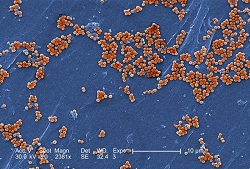 |
| Lumps of methicillin-resistant Staphylococcus aureus bacteria, or MRSA (orange), magnified 2381x--Courtesy of CDC/Janice Haney Carr |
As the threat of antibacterial resistance rises, new antibiotics are sorely needed as microbes mutate and get better at outsmarting current therapies available for bacterial infections.
Researchers from the University of Notre Dame may have discovered a new class of antibiotics to combat deadly bacteria like methicillin-resistant Staphylococcus aureus, or MRSA, which pose serious threats to public health.
Led by Mayland Chang and Shahriar Mobashery, investigators identified the new class of antibiotics, called oxadiazoles, by using virtual screening to sift through 1.2 million compounds.
Researchers found that the oxadiazoles work by inhibiting a penicillin-binding protein, PBP2a, and the biosynthesis of the cell wall that enables MRSA to resist other drugs. In mouse models, the class of drugs was able to ward off infection of MRSA. The oxadiazoles were also effective when taken orally, an attractive feature since only one oral antibiotic for MRSA exists--linezolid, marketed by Pfizer ($PFE) as Zyvox. Most moderate to severe infections of MRSA need to be treated by intravenous antibiotics like trimethoprim-sulfamethoxazole (Bactrim), doxycycline (Vibramycin) and clindamycin (Cleocin). Resistance to each of these drugs already exists and is growing.
The research was published recently in the Journal of the American Chemical Society.
Rates of MRSA infections are increasing in places like hospitals, jails and schools where people come in close contact with one another. In the U.S., 278,000 people are hospitalized and 19,000 die each year from infections caused by MRSA.
"As we understand what the mechanisms are, we can devise strategies to develop compounds against MRSA," Chang said in a university statement.
- see the study abstract
- read the press release